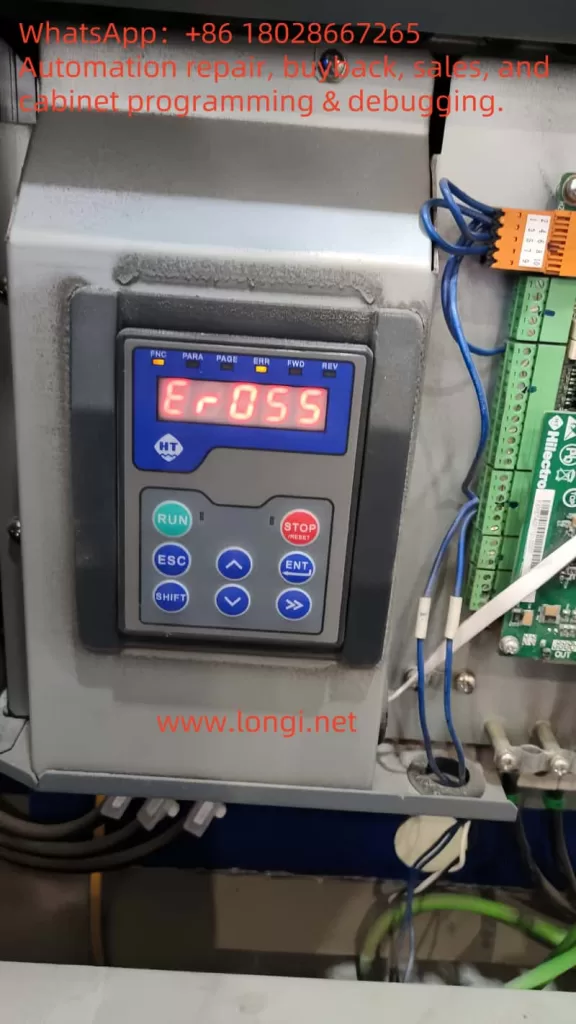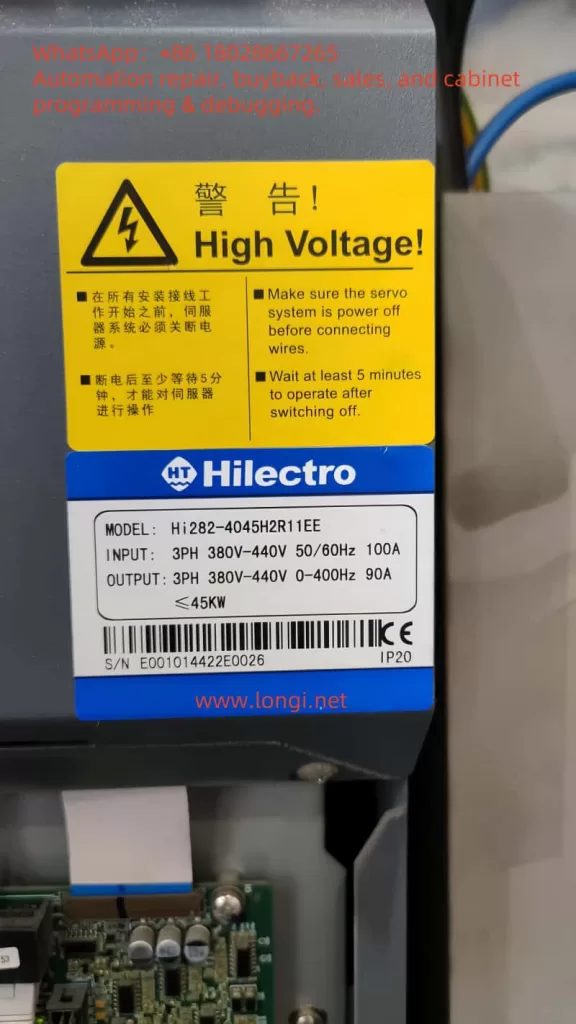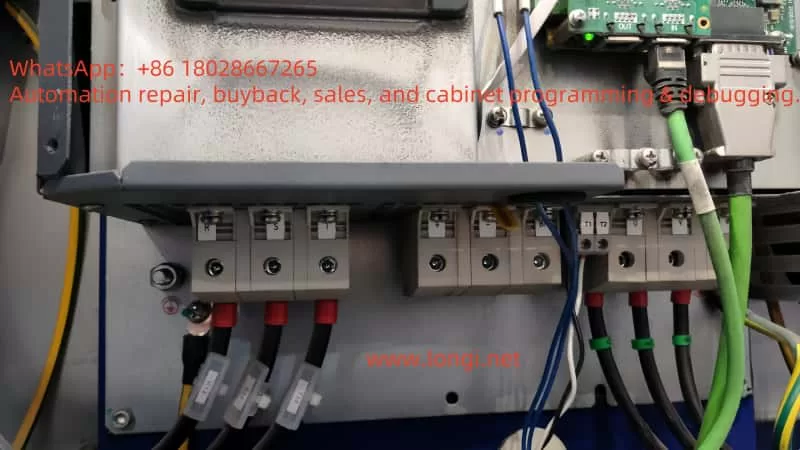Introduction
In the realm of industrial automation, servo systems are pivotal for achieving precise motion control, finding widespread use in CNC machines, robotics, packaging lines, and more. However, as complex electronic devices, servo systems can encounter faults that disrupt production. The ER055 hardware overvoltage fault (Hardware Overvoltage Fault) in the Hilectro HI282 series servo system is a common issue that can severely impact equipment operation. This article delves into the meaning of the ER055 fault, its potential causes, resolution methods, and preventive measures, empowering users to diagnose and address the problem efficiently while ensuring system stability.

Meaning of the ER055 Fault
The ER055 fault code in the Hilectro HI282 series servo system signifies a “hardware overvoltage” condition. This indicates that the internal voltage within the servo driver has exceeded its safe operating range, potentially triggering protective mechanisms that halt operation. According to the HI2xx series servo manual (Version 5.51), fault codes are typically displayed as “ErOSX,” where X denotes a specific fault number. For instance, “ErOS5” corresponds to fault number 53, indicating a system error. ER055 likely represents fault number 55, specifically a hardware overvoltage error, often linked to power supply, regenerative energy, or hardware issues requiring immediate attention.
Common Causes of ER055 Hardware Overvoltage Fault
Several factors may contribute to a hardware overvoltage fault, including:
- Excessive Power Supply Voltage
If the voltage supplied to the servo driver exceeds its rated value, it can trigger overvoltage protection. For example, the HI282 series driver typically operates within a specified voltage range (details in the manual), and exceeding this range can lead to an ER055 fault. - Excessive Regenerative Energy
During rapid motor deceleration, the servo motor generates regenerative energy (converting kinetic energy into electrical energy fed back to the driver). If the driver’s regenerative resistor lacks sufficient capacity or is faulty, this energy can cause internal voltage spikes, triggering the fault. - Internal Component Failure
Faulty voltage detection circuits, power modules, or capacitors within the driver can lead to inaccurate voltage monitoring or actual voltage anomalies. For instance, aged capacitors or damaged transistors might be culprits. - Wiring and Grounding Issues
Improper wiring, loose connections, or inadequate grounding can result in voltage fluctuations or interference, activating overvoltage protection. Examples include loose power lines or improper grounding setups.
The following table summarizes potential causes and their characteristics:
| Cause | Characteristics | Potential Impact |
|---|---|---|
| Excessive Power Voltage | Input voltage exceeds rated range | Driver halts, displays ER055 |
| Excessive Regenerative Energy | Voltage rise during rapid deceleration | Overvoltage protection triggered |
| Internal Component Failure | Abnormal voltage detection or hardware damage | Frequent faults or unresolvable issues |
| Wiring/Grounding Issues | Voltage spikes or interference | Unstable operation, intermittent faults |

Steps to Resolve ER055 Hardware Overvoltage Fault
Resolving an ER055 fault requires a systematic troubleshooting approach. The following steps are recommended:
- Check Power Supply Voltage
- Use a multimeter to measure the input voltage to the servo driver, ensuring it aligns with the rated range specified in the HI282 manual.
- If the voltage is too high, inspect the power source (e.g., transformer or regulator) and adjust it accordingly.
- Ensure power stability to avoid fluctuations or spikes.
- Inspect Regenerative Resistor
- Confirm the presence and functionality of the regenerative resistor.
- Check for signs of burnout, open circuits, or shorts.
- Replace with a resistor of adequate capacity if it’s insufficient (refer to manual recommendations).
- Inspect Internal Components
- Look for abnormal signs in the driver, such as overheating, unusual noises, or a burnt smell, which may indicate component failure.
- Note: Non-professionals should not disassemble the driver; contact a Hilectro authorized service center for repairs.
- Examine Wiring and Grounding
- Ensure all power, signal, and ground connections are secure and correctly configured, with no loose or broken wires.
- Verify grounding meets manufacturer standards, as proper grounding reduces interference and voltage spikes.
- Use an oscilloscope to check for voltage surges or electromagnetic interference.
- Reset the Driver
- Attempt a power cycle by disconnecting the power, waiting a few minutes, then restarting to see if the fault clears.
- If the driver has a “STOP” button, press it to attempt clearing the error state (ERR status), returning the driver to READY mode.
- Review Parameter Settings
- Access the driver’s parameter settings to check configurations related to voltage or regenerative control.
- If misconfigured, restore factory settings or adjust parameters per the manual.
- Consult the Manual or Contact Technical Support
- Refer to the HI282 series user manual for the specific definition of ER055 and recommended troubleshooting steps.
- If unavailable or unresolved, contact Hilectro technical support with details of the fault code and operating conditions.
- Consider Driver Replacement
- If the above steps fail and the driver is out of warranty or repair costs are high, consider replacing it.
- Ensure the new driver’s model and specifications are compatible with the system.
The following table outlines the resolution steps and precautions:
| Step | Action | Precautions |
|---|---|---|
| Check Power Voltage | Measure input voltage | Stay within rated range |
| Inspect Regenerative Resistor | Check status and capacity | Avoid using damaged or mismatched resistors |
| Inspect Internal Components | Observe for anomalies | Require professional handling |
| Check Wiring/Grounding | Ensure secure connections, proper grounding | Check for voltage spikes or interference |
| Reset Driver | Power cycle or press STOP button | Record fault status before/after |
| Review Parameters | Adjust or reset settings | Refer to manual to avoid errors |
| Contact Support | Provide fault details | Prepare model and logs |
| Replace Driver | Select compatible model | Ensure system compatibility |
Preventive Measures for ER055 Faults
To prevent recurrence of ER055 faults, consider the following measures:
- Regular Maintenance
- Periodically inspect the driver’s operating condition, including temperature, noise, and vibration.
- Clean cooling fans and heat sinks to ensure effective heat dissipation.
- Check the aging of capacitors, resistors, and other wear-prone components, replacing them as needed.
- Stable Power Supply
- Use reliable power equipment to maintain input voltage within the driver’s rated range.
- Install voltage regulators or UPS (uninterruptible power supply) to mitigate voltage fluctuations.
- Proper Acceleration/Deceleration Control
- Set reasonable acceleration and deceleration times in the servo system’s control parameters to minimize regenerative energy.
- Ensure the regenerative resistor’s capacity is sufficient for rapid deceleration scenarios.
- Correct Wiring and Grounding
- Follow the manual’s guidelines for wiring and grounding to prevent faults caused by improper connections.
- Use shielded cables to reduce electromagnetic interference.
- Train Operators
- Ensure operators are familiar with the servo system’s operation and maintenance, enabling them to identify and report issues promptly.
- Provide training on fault troubleshooting and prevention to enhance team capability.

Conclusion
The ER055 hardware overvoltage fault is a common issue in the Hilectro HI282 series servo systems, typically caused by excessive power voltage, regenerative energy overload, internal component failure, or wiring problems. Through systematic troubleshooting—such as checking the power supply, regenerative resistor, wiring, and parameter settings—users can effectively resolve this fault. Additionally, adopting preventive measures like regular maintenance, stable power, and proper control settings can significantly reduce fault occurrences, ensuring long-term system reliability. If the problem persists, contacting Hilectro technical support or a professional repair service is advised for detailed guidance or repairs.
